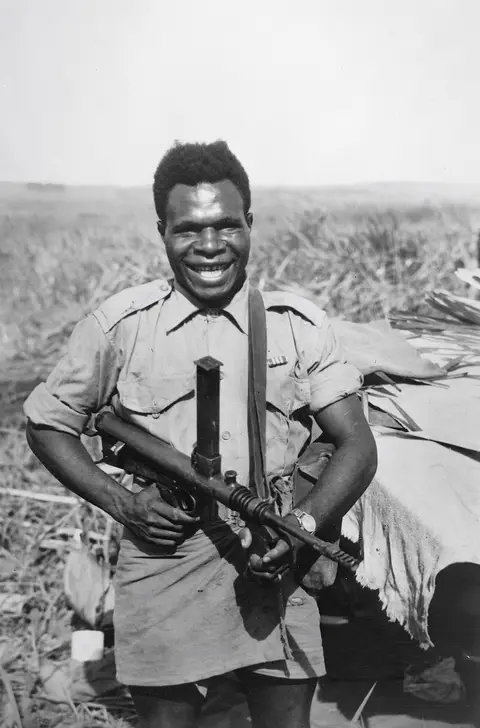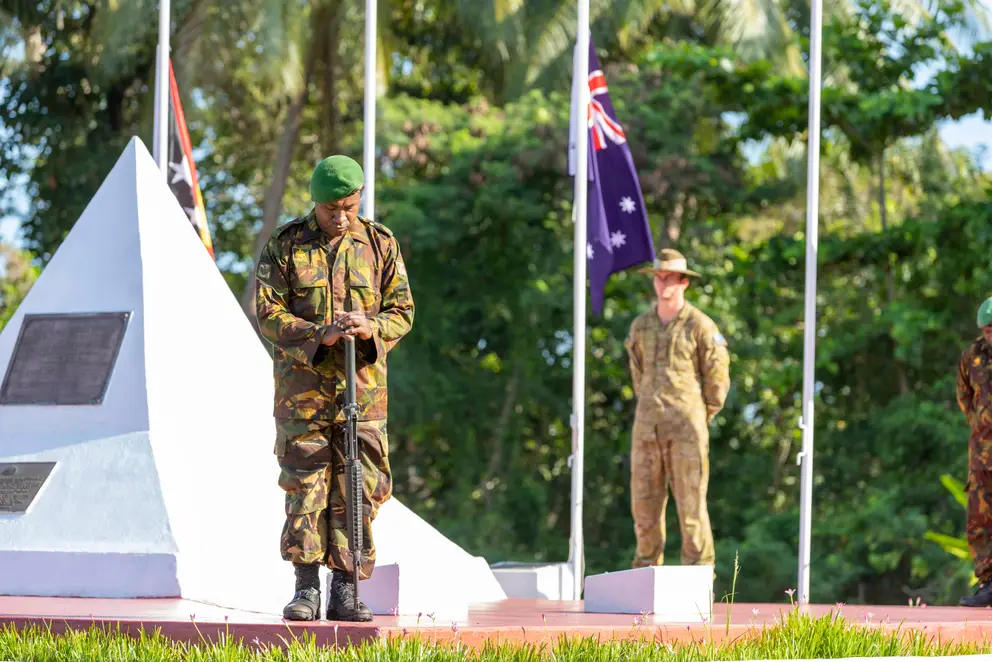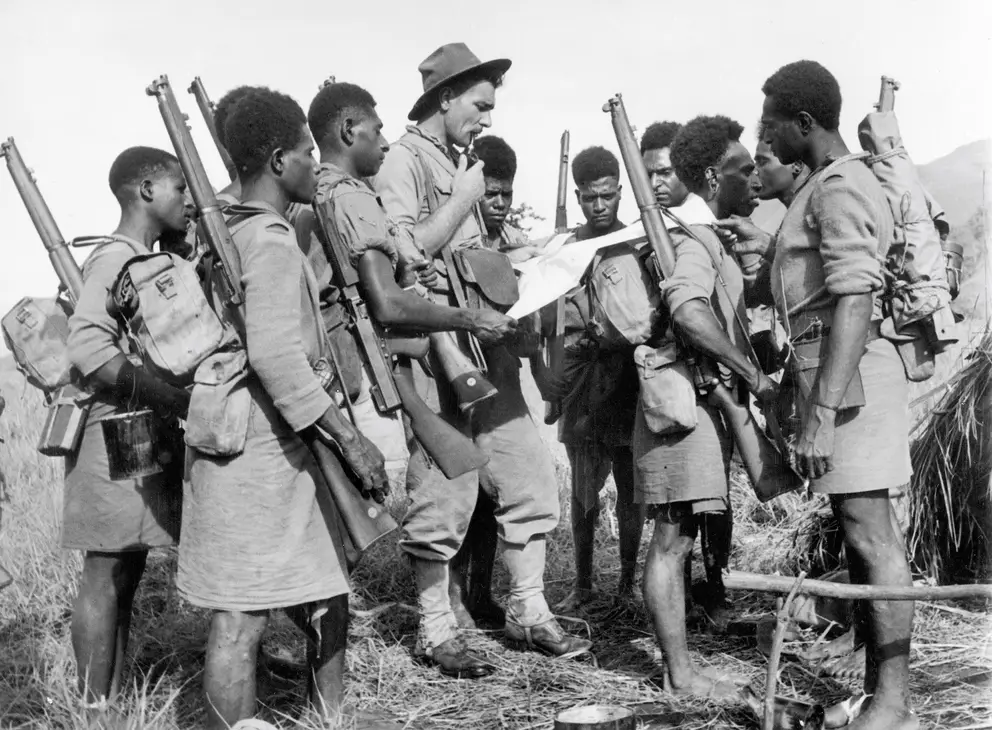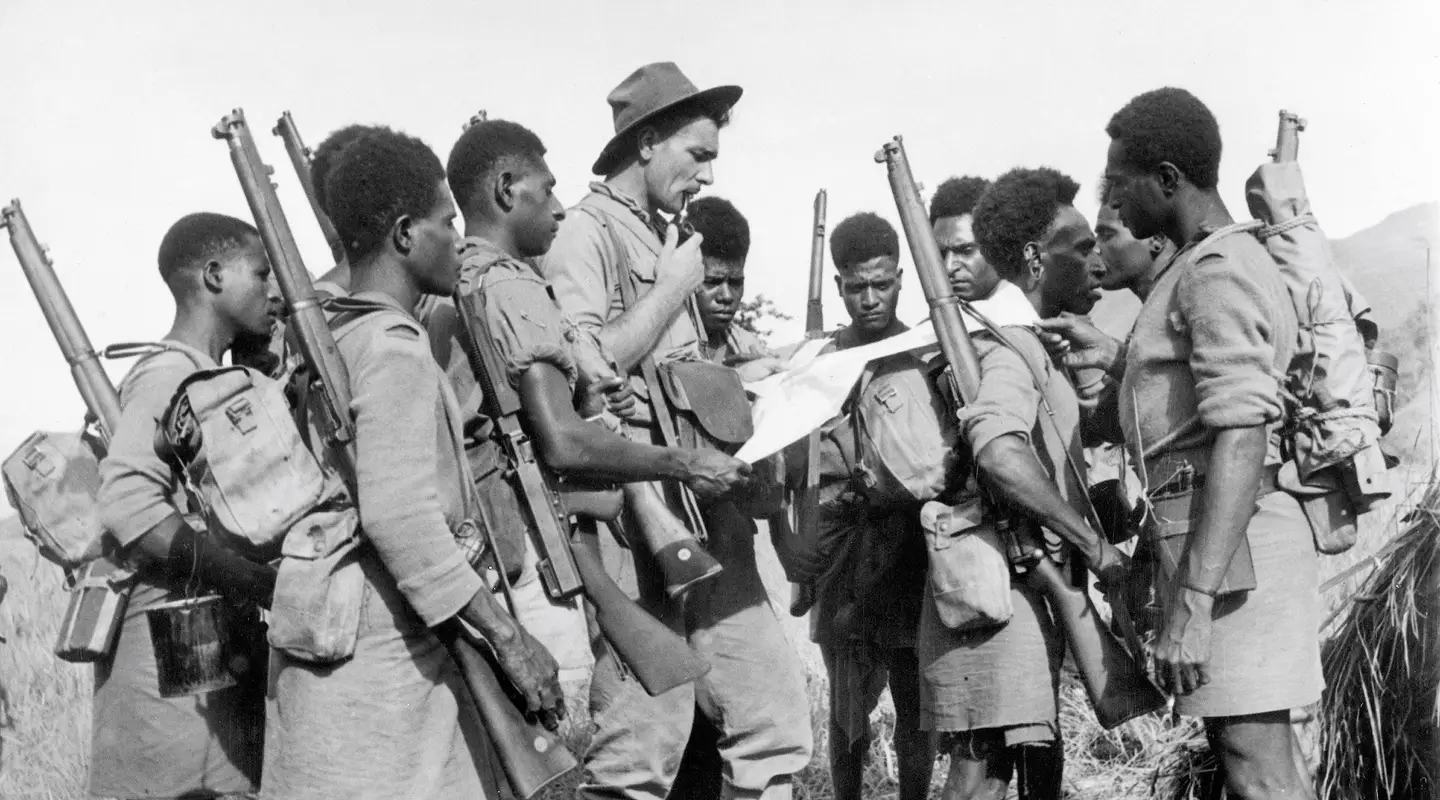Australia’s long defence relationship with Papua New Guinea is based in shared history.
On 13 September 2019, Australian and Papua New Guinean soldiers assembled on Cape Wom, west of Wewak on Papua New Guinea’s northern coast, to mark the 74th anniversary of the surrender of Japanese troops on the island. The troops standing to attention on the former wartime airfield came from 3rd Battalion, Royal Australian Regiment, and 2nd Battalion, Royal Pacific Islands Regiment; rather than assembling along national lines, the ranks of men and women were intermingled, Papua New Guinean next to Australian. The soldiers making up the catafalque party were similarly bi-national, standing guard over the plaque commemorating the moment when Lieutenant General Adachi Hatazō formally surrendered to the Australian Major General Horace Robertson in front of soldiers of 6th Australian Division.
That members of the Papua New Guinea Defence Force (PNGDF) and Australian Defence Force (ADF) stood side by side reflects a long defence relationship that stretches back to 1940. This relationship has waxed and waned through colonial turpitude, decolonisation, ugly civil wars and frequent Australian “rediscoveries” of the Pacific. But it has remained a constant.
The officer in command of the Australians present at Cape Wom in September 2019, Brigadier Scott Winter, Commander 3rd Brigade, is clear about the circumstances in which the military relationship between the two nations has flourished. When Australia is invested in the country and its people, and seeks to learn as well as teach, the partnership is strong.
Australia must, Brigadier Winter argues, have “skin in the game”. The successes and failures of the Australian armed forces’ relationship with Papua New Guineans over the last 80 years are testament to this.
The Second World War
Security has long been a part of the relationship between Australia and PNG. Australia annexed the southern portion of the island, Papua, in 1888 to provide a barrier against German expansion in the Pacific. In 1914, Australia launched an expedition to take New Guinea from Imperial Germany. In both cases, Australia’s nearest neighbour was seen as vital to its defence.
It was PNG’s tortuous terrain that aided Australia’s defence, so it was not until more than 50 years after annexation, in the shadow of the Second World War, that the first Papua New Guineans were recruited into the armed forces. In 1940, the Papuan Infantry Battalion (PIB) was raised in Port Moresby. This unit was conceptualised as a reconnaissance and raiding force and was commanded by Australian officers and non-commissioned officers. Later in the war a number of New Guinea Infantry Battalions (NGIB) were also created, and these were grouped together with the PIB to form the Pacific Islands Regiment (PIR).
1 Papuan Infantry Battalion training
[silent]
The PIR was colonial in its structure: Papua New Guineans had low pay, different uniforms, and were not considered the equal of Australian troops. Despite being seen as a second-tier unit, the PIR performed well on the battlefield, scouting for Australian units and exacting a heavy toll as raiders on the Japanese. Some described the Papua New Guineans as “green shadows”.
Ultimately, the PIR participated in every campaign in Papua and New Guinea, save for that at Milne Bay. It was, for instance, the 2nd Battalion NGIB that fought alongside 6th Division in 1945 on their advance to Wewak and Lieutenant-General Adachi’s headquarters. However, the PIR was disbanded after the war for reasons of cost and because Australian colonial authorities were fearful of armed and trained colonial subjects.
Australia’s colonial army
In the shadow of the Cold War, fears about possible invasion from the north saw the newly created Australian Army turn to Papua New Guinean troops to defend PNG, and the PIR was re-raised in 1951. With the Army focused on the Korean War, Papua New Guinean troops were seen as an inexpensive way to defend Australia’s north.

Corporal Sala, who served with the 1st Papuan Infantry Battalion, was awarded the Military Medal for his outstanding bravery against the Japanese. Kelanoa, New Guinea, 4 March 1944.
The PIR was again regarded as an auxiliary unit, as it had been during the Second World War. Papua New Guinean troops were still perceived as only good enough to act in support of Australian troops, should war break out again. They were not issued shoes, could not rise to sergeant or above, and were issued only seven items in their rations: rice, meat, biscuits, margarine, salt, tea and sugar.
One officer from Northern Command, PIR’s parent Headquarters, wrote in 1956 that Papua New Guineans were “unsophisticated”, having “little better than a primitive culture and background”, and displaying a “childish enthusiasm”. The regiment was on the bottom of the Army’s priority list for Australian officers as well, both in terms of quality and quantity. It never had enough leaders, and those that were sent were unwanted in other, more prestigious commands.
The lack of attention paid to the PIR came back to haunt the Army, in two so-called disturbances. In 1957, around 100 members of the regiment took part in a riot in the local market, in response to insults thrown at them by civilians. Australian officers had remained blissfully unaware of the growing tensions; the only officer who spoke the soldiers’ language was on leave.
In 1961, some soldiers rioted again, this time because the promised one-third pay rise had been sitting on a desk in Canberra for over a year. Again, Australian soldiers were unable to forestall their men’s actions.
Australian civilians in PNG at the time were shocked by both disturbances, not least because of their fear of a “colonial uprising”. While their fears were misplaced, as the Papua New Guineans’ anger was not directed at the government, both incidents revealed serious problems in the Army’s management of the PIR. Not only had the officers neglected to understand their men, but the Defence department in Canberra had failed to adequately support the unit.
Change was swift. The Australian Army sought to ensure that a “definite type” of officer was sent to PNG: men who could work with other cultures, and who understood that Papua New Guineans required different approaches.
Confrontation and independence
The changes caused by the two riots were compounded by two seismic shifts over the next decade. First, Indonesia took over West Papua. For the first (and only) time, Australia shared a land border with a potentially hostile nation. Reacting to concurrent instability in south-east Asia, the Menzies government authorised the expansion of Australia’s armed forces, and the PIR with it. Throughout the 1960s, racially based restrictions on Papua New Guineans were lifted, including drinking, voting, and occupying more senior positions in the public service. For the first time, they could rise in the ranks, and the Army was quick to recruit the first two Papua New Guinean officers in 1963.
The PIR soon expanded to two battalions, and a PNG Command was created in 1965 to manage them. Tasked with patrolling the border to detect Indonesian incursions, PNG Command came to be seen not as an auxiliary to Australian forces, but instead as capable of acting as Australia’s first line of defence.
In the event of war, PNG Command was to deploy troops to the border under an operational plan codenamed Pygmalion. In the first phase of the plan, PIR patrols would have detected Indonesian incursions, and then deployed two battalions, one on either side of the central mountain range. Operating from patrol bases, platoon and company-sized patrols would have found and engaged Indonesian forces in a concept of operations that matched that employed by Australian battalions during Confrontation in Borneo.
With the end of Confrontation with Indonesia in 1966, PNG Command shifted its focus from defending the border to preparing for eventual Papua New Guinean independence. While the timeline for this was vague, PNG Command saw the writing on the wall, and prepared on its own initiative.
It started with a huge education program for its troops from 1966, aiming to create a body of Papua New Guinean soldiers who had a foundation of basic subjects such as English, science and mathematics, but who also had received a thorough grounding in so-called “civics”. These classes taught Papua New Guinean soldiers their place in a democratic state, and aimed, in the words of the then Commander of PNG Command, Brigadier Ian Hunter, at “creating a national army before there is a nation”.
The education program reached all troops in PNG Command, making it one of the most highly educated bodies in PNG at the time. This ambitious undertaking was only possible through the use of hundreds of Australian national servicemen, chosen for having teaching degrees. These men – known as Chalkies because of their use of blackboards – served on every PNG Command base, usually for around a year.
The PNG Command of the late 1960s was therefore a far different organisation from that of just a decade earlier. With a literacy rate far higher than that of the general population, Papua New Guinean soldiers had received a comprehensive education in the political changes occurring around them. In addition, Papua New Guineans were increasingly present at higher ranks within the force: the first indigenous officers were recruited in 1963, and the Army gradually replaced Australian personnel with Papua New Guineans: by the 1970s, most NCOs and lieutenants in the infantry were local men.
The Army’s focus on preparing its soldiers for independence was remarkable in the context of the Australian government’s tardiness in setting a timetable for decolonisation. It was only in 1971 that a firm date for PNG’s independence was set. By then, PNG Command, which became the Papua New Guinea Defence Force in 1973, was far better prepared for independence than it might have been.
In the decades leading up to that moment, Australia had learnt a number of hard lessons about how to manage a force composed of men who were as ethnically, culturally and linguistically different from European Australia as it was possible to be. Indeed, the presence of thousands of Papua New Guineans – around one in ten of the regular force – made the Australian Army one of the most diverse armed forces in the world.
Independence and after
Independence came on 16 September 1975 when the Australian flag was lowered in Port Moresby. Australia left PNG because of a combination of international and domestic pressure to divest itself of its colonial territory, and it did so in what some have subsequently seen as a rush. Unlike other instances of decolonisation, however, that in PNG was peaceful.
In 1975 there were still around 600 members of the Australian military in PNG, but these were removed over the next five years. In their place came Australian personnel tasked with providing advice and training, and at times occupying seconded positions within the PNGDF. From the 1990s, around 30 of these men and women have been in PNG at any one time.

Papua New Guinean and Australian soldiers form the catafalque party during the commemoration ceremony. Photo: Tpr Jarrod McAneney; courtesy Department of Defence.
After independence the PNGDF, like the country it served, had a chequered experience. In 1980 the force had its most notable success, deploying two companies to Vanuatu on a peacekeeping mission. By the 1990s, however, low defence budgets and systemic problems within the force made the PNGDF ill-disciplined and lacking in capability.
The conflict in Bougainville between 1988 and 1998 was a particular low point. Between 10,000 and 15,000 Bougainvilleans died in the civil war, as well as 300 members of the PNGDF, with several thousand wounded. The number of military dead was thus far more than those suffered by Australia in all conflicts after Vietnam; yet the conflict is little known outside PNG. The PNGDF was also accused of ill-discipline on Bougainville. Australia played a role in ending violence on the island, supporting peace talks and the subsequent deployment of the Truce Monitoring Group in 1997.
Throughout this time the relationship between the ADF and the PNGDF was often strained, as the political situation precluded close interaction, and as Australia focused on the post Vietnam War “defence of Australia” strategy. More broadly, this reflected the ongoing Australian uncertainty about the nature of its relationship with its former colonial territory. Journalist Sean Dorney, for instance, has called Australia’s attitude that of an “embarrassed colonialist”.
The 21st-century relationship
Today, around 30 Australian defence personnel are permanently posted to Papua New Guinea as part of the Defence Cooperation Program (DCP). This program, which celebrated its 40th anniversary in 2019, is the largest program of its kind that Australia mounts; it facilitates a range of assistance, such as training, infrastructure projects and the exchange of personnel. Hundreds of Papua New Guineans have trained in Australia since independence, including those attending Australian Command and Staff College and the Australian Defence Force Academy.
Combined exercises between the PNGDF and the ADF are an important part of the DCP. The Australian Army plays a particularly important role in such exercises, as each of the Army’s three combat brigades is aligned with a region: 1st Brigade (Darwin) with Indonesia and Timor-Leste, 7th Brigade (Brisbane) with the south-west Pacific and 3rd Brigade (Townsville) with PNG. The 3rd Brigade’s engagement with PNG ranges from short exercises with a handful of individuals, to months-long training that may see an entire rifle company and supporting elements deployed to PNG, with visits from Royal Australian Navy ships and air support from the Royal Australian Air Force. Many of the exercises also take place at 3rd Brigade’s base in Townsville. These exercises are collectively termed Exercise Olgeta Warrior.
Exercises conducted together are not just about building the capability of the PNGDF. Australian soldiers learn from their Papua New Guinean counterparts. They experience operations in some of the harshest jungle terrain in the world. They also develop new understandings of the culture and outlook of Australia’s largest recipient of defence aid, and they develop skills in cross-cultural military engagement that have stood them in good stead in other circumstances, such as the Middle East.

The men of the 1st Papuan Infantry Battalion were excellent scouts. Here an Australian officer briefs his men before a patrol. 8 November 1943. Photo: Neil Brown.
The shared history of the Second World War is an important part of this relationship. The war still looms large in PNG; even major towns owe their layout to the wartime influx of men and equipment, and memorials and battlefields dot the country. Papua New Guineans made a significant contribution to the eventual Allied victory, providing carriers and the soldiers of the PIR.
History is deeply rooted in the ADF’s relationship with Papua New Guinea and its people. As part of 2019’s Exercise Wantok Warrior, members of 3RAR travelled to the village of Kiarivu, a village in the hills south of Wewak, to restore their war memorial. It was at Kiarivu in 1945 that Lieutenant-General Adachi was first captured by Australian troops. Thousands of locals attended the unveiling; Australian soldiers stood at attention, and local school children sang the national anthem. The centrepiece was the raising of the Papua New Guinean flag by the son of the man who, upon seeing Australian troops arrive in 1945, had climbed a coconut tree and removed the Japanese flag, replacing it with an Australian one, ending the three years of Japanese occupation.
The deeply felt shared history is not abstract for many Papua New Guineans; it is part of their living memory. The relationship between Australia and PNG is one that has waxed and waned in the context of war, colonialism and fraught bilateral relations. Yet members of the ADF are still the beneficiaries of a very real sense of shared history. Maintaining the monument at Kiarivu and standing alongside their PNGDF counterparts at the surrender commemorations at Cape Wom, the ADF reinforces these links, to the benefit of both countries. It is through such efforts that the ADF keeps “skin in the game”.

